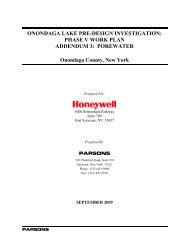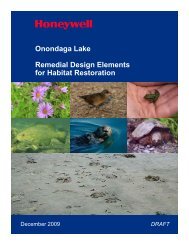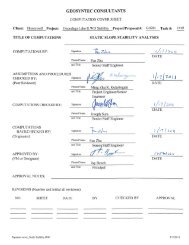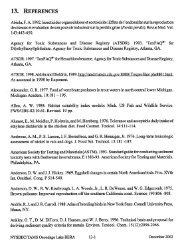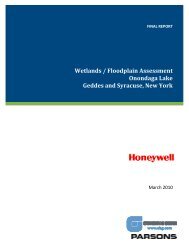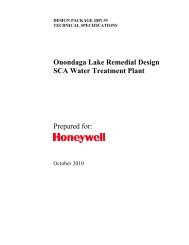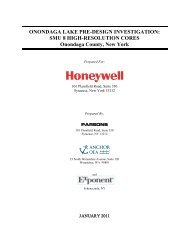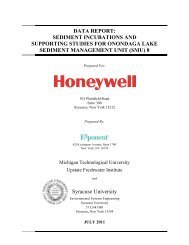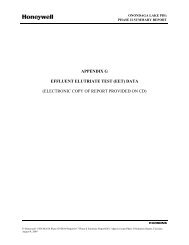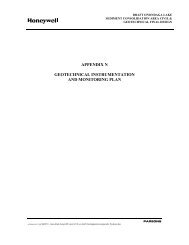Phase 1B Underwater Archaeological Report for the Onondaga ...
Phase 1B Underwater Archaeological Report for the Onondaga ...
Phase 1B Underwater Archaeological Report for the Onondaga ...
Create successful ePaper yourself
Turn your PDF publications into a flip-book with our unique Google optimized e-Paper software.
FINAL<br />
<strong>Phase</strong> IB <strong>Underwater</strong> <strong>Archaeological</strong> Resources <strong>Report</strong> <strong>for</strong> <strong>Onondaga</strong> Lake Superfund Site<br />
importance of <strong>the</strong> resources used to make <strong>the</strong>se nets. A fishnet made of “Indian-hemp fiber” which was<br />
woven into a net with about a two inch (5.1cm) mesh, was found at <strong>the</strong> site. 34<br />
The Brewerton <strong>Phase</strong> is best represented by <strong>the</strong> Brewerton type site located at <strong>the</strong> outlet of Oneida<br />
Lake. People of this phase appear not to have placed as much importance on fishing as <strong>the</strong>y did during<br />
<strong>the</strong> Lamoka <strong>Phase</strong>. Brewerton sites tend to yield a smaller number of notched sinkers (or stone<br />
plummets), barbed fishing hooks and spear fishing devices. The Brewerton site, however, is located<br />
near <strong>the</strong> rifts below Oneida Lake, an optimal location <strong>for</strong> <strong>the</strong> seasonal fish runs, where fish can be<br />
trapped and speared. 35 Also noteworthy at <strong>the</strong> Brewerton site was a large number of woodworking<br />
tools, such as grooved axes, gouges, and adzes. 36 Ritchie notes that <strong>the</strong> presence of gouges in site<br />
assemblages implies <strong>the</strong> construction and use of <strong>the</strong> dugout canoes. 37<br />
The Frontenac <strong>Phase</strong> is best represented by <strong>the</strong> Frontenac Island site located in Cayuga Lake. It is <strong>the</strong><br />
only island in <strong>the</strong> Finger Lakes, about an acre (.4 hectare). Excavations unear<strong>the</strong>d various faunal<br />
remains, including birds, reptiles, mammals, mollusks and fish. 38 Fishing gear included notched stone<br />
net sinkers, bone fishhooks, bone gorges, fishing spears, and stone plummets. Ritchie suggests that<br />
stone plummets were used <strong>for</strong> line fishing, and to assess water depth. He also notes that unlike <strong>the</strong><br />
Lamoka sites, <strong>the</strong>re were no tools found that indicate <strong>the</strong> manufacture of nets. 39 Woodworking tools<br />
were also part of <strong>the</strong> site assemblage, and it can be assumed that some type of boat building was<br />
required at this island site.<br />
The Transitional Period (3,500 to 3,000 BP)<br />
The Transitional Period is characterized by hunting and ga<strong>the</strong>ring groups with an increased reliance on<br />
plant materials. Frost Island <strong>Phase</strong> sites are more common to <strong>the</strong> north of <strong>the</strong> Finger Lakes, such as <strong>the</strong><br />
type site along <strong>the</strong> Seneca River. The assemblage from this site yielded notched pebble sinkers,<br />
suggesting that fishing with nets was likely. 40<br />
The Orient <strong>Phase</strong> appears to be centered on <strong>the</strong> sou<strong>the</strong>astern part of New York; hence, much of what is<br />
known is based on sites near Long Island. However, recent discoveries have shown that this phase may<br />
have extended into <strong>the</strong> nor<strong>the</strong>rn Hudson region. It appears that shellfish was an important food source,<br />
ga<strong>the</strong>red from mudflats and shallow bays. 41<br />
The Early and Middle Woodland Period (3,000 to 1100 BP)<br />
The Early and Middle Woodland periods are marked by <strong>the</strong> increased interaction between peoples in<br />
north and central New York with groups to <strong>the</strong> west in Ohio (i.e. Adena, Hopewell) and north and west<br />
in <strong>the</strong> Great Lakes region. The most important cultural factor during this broader period is <strong>the</strong> sharing<br />
and exchange of ideas and cultural materials with neighboring regions. It indicates that although<br />
regionally groups of people were becoming more sedentary and establishing permanent settlements,<br />
<strong>the</strong>y were also highly mobile with <strong>the</strong> long distance movement of ideas and materials, most likely<br />
making use of canoes <strong>for</strong> inland waterway travel. Stylistically, material culture distinguishes <strong>the</strong> Early<br />
and Middle Woodland sites from one ano<strong>the</strong>r, but Hohman notes that <strong>the</strong>ir land use patterns were both<br />
based on an “organized system where seasonal base camps with as many as 100 individuals were<br />
established in major river and lake valleys near streams confluences.” 42 With a larger base camp<br />
established, daily or even weekly <strong>for</strong>ays <strong>for</strong> nearby resources were carried out by smaller groups, and<br />
this type of logistical subsistence pattern resulted in various site types representing <strong>the</strong>se time<br />
periods. 43 It is likely that during this period native peoples used dugout canoes, while innovative<br />
methods <strong>for</strong> constructing lighter craft may have been developed at this time.<br />
8



